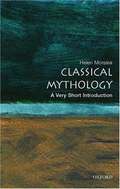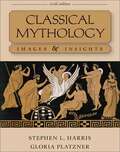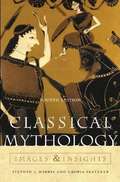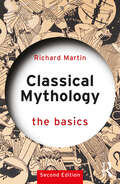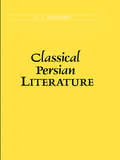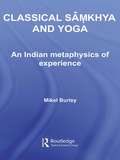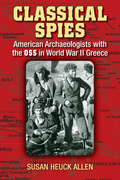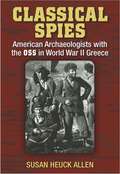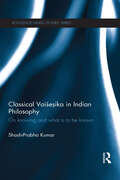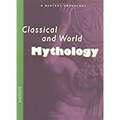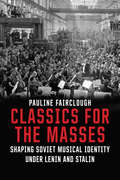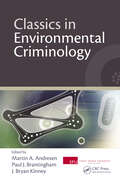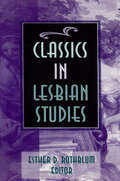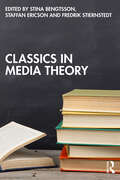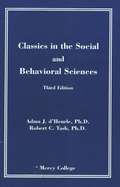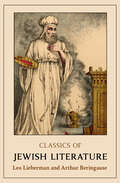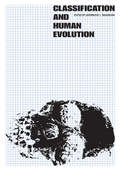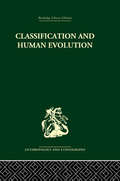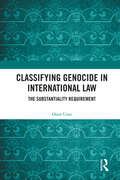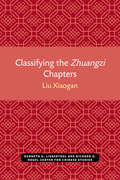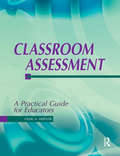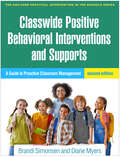- Table View
- List View
Classical Mythology: A Very Short Introduction
by Helen MoralesFrom Zeus and Europa, to Diana, Pan, and Prometheus, the myths of ancient Greece and Rome seem to exert a timeless power over us. But what do those myths represent, and why are they so enduringly fascinating? Why do they seem to be such a potent way of talking about our selves, our origins, and our desires? This imaginative and stimulating Very Short Introduction goes beyond a simple retelling of the stories to explore the rich history and diverse interpretations of classical mythology. It is a wide-ranging account, examining how classical myths are used and understood in both high art and popular culture, taking the reader from the temples of Crete to skyscrapers in New York, and finding classical myths in a variety of unexpected places: from Arabic poetry and Hollywood films, to psychoanalysis, the Bible, and New Age spiritualism.
Classical Mythology: Images and Insights
by Gloria Platzner Stephen HarrisClassical Mythology: Images and Insights approaches the study of myths through complete works of Greco-Roman literature, including six complete Greek dramas and generous excerpts from the narratives of Homer, Hesiod, Virgil, and Ovid, and through carefully chosen examples of classical works of art, both painting and sculpture. Combining literary masterpieces with the visual arts, this integrative approach offers readers a comprehensive experience with both cognitive and aesthetic appeal.
Classical Mythology: Images and Insights, Fourth Edition
by Gloria Platzner Stephen L. HarrisAn introduction to Greek and Roman mythology combining theoretical treatment of myth with primary literature and art. Incorporates selections and complete works of Greco-Roman myths such as Hesiod's Theogony, the Homeric hymns, and Ovid's Metamorphoses, with critical introductions and discussion and review questions. Discusses Greek myth's concepts and divinities, contrasts Greek and Roman myth, modern art and literature incorporating mythology. Includes a separate chapter devoted to the Great Goddess. Annotation c. by Book News, Inc., Portland, Or.
Classical Mythology: The Basics (The Basics)
by Richard MartinThis new edition introduces the core elements of ancient Greek and Roman narratives about immortal gods and heroic humans. It explains how myths once shaped ancient ways of thinking, and how they have fascinated and inspired artists, writers, musicians, scientists, and scholars since. In six clear and concise chapters, this book explains what myths are, sketches the main stories about divinities, heroes and heroines, and explores through specific case studies the ways in which they influenced modern culture, from Renaissance opera to contemporary video games and social movements. The second edition also features a new chapter analyzing how myths have been used in politics from antiquity to the present day. More than two dozen illustrations, maps, and charts complement the text. No prior knowledge of mythology is assumed, and the book incorporates the latest scholarship on classical mythology, providing annotated lists of further readings. Anyone who has encountered Greek or Roman myths in literature, art, or pop culture and wants to know more about the cultural contexts for the stories will benefit from this compact book. Intended for a wide readership, the second edition of Classical Mythology: The Basics continues to off er a clear introduction to the subject for undergraduates, scholars, and the general reader.
Classical Persian Literature (Routledge Revivals: Selected Works Of A. J. Arberry Ser. #3)
by A.J ArberryReprint of a classic text.
Classical Samkhya and Yoga: An Indian Metaphysics of Experience (Routledge Hindu Studies Series)
by Mikel BurleySamkhya and Yoga are two of the oldest and most influential systems of classical Indian philosophy. This book provides a thorough analysis of the systems in order to fully understand Indian philosophy. Placing particular emphasis on the metaphysical schema which underlies both concepts, the author adeptly develops a new interpretation of the standard views on Samkhya and Yoga. Drawing upon existing sources and using insights from both Eastern and Western philosophy and religious practice, this comprehensive interpretation is respectful to the underlying spiritual purpose of the Indian systems. It serves to illuminate the relation between the theoretical and practical dimensions of Samkhya and Yoga. The book fills a gap in current scholarship and will be of interest to those concerned with Indology as well as philosophies in general and their similarities and differences with other traditions.
Classical Spies: American Archaeologists with the OSS in World War II Greece
by Susan Heuck Allen"Classical Spies will be a lasting contribution to the discipline and will stimulate further research. Susan Heuck Allen presents to a wide readership a topic of interest that is important and has been neglected. " -William M. Calder III, University of Illinois, Urbana-Champaign. Classical Spies is the first insiders' account of the operations of the American intelligence service in World War II Greece. Initiated by archaeologists in Greece and the eastern Mediterranean, the network drew on scholars' personal contacts and knowledge of languages and terrain. While modern readers might think Indiana Jones is just a fantasy character, Classical Spies discloses events where even Indy would feel at home: burying Athenian dig records in an Egyptian tomb, activating prep-school connections to establish spies code-named Vulture and Chickadee, and organizing parachute drops. Susan Heuck Allen reveals remarkable details about a remarkable group of individuals. Often mistaken for mild-mannered professors and scholars, such archaeologists as Princeton's Rodney Young, Cincinnati's Jack Caskey and Carl Blegen, Yale's Jerry Sperling and Dorothy Cox, and Bryn Mawr's Virginia Grace proved their mettle as effective spies in an intriguing game of cat and mouse with their Nazi counterparts. Relying on interviews with individuals sharing their stories for the first time, previously unpublished secret documents, private diaries and letters, and personal photographs, Classical Spies offers an exciting and personal perspective on the history of World War II"--
Classical Spies: American Archaeologists with the OSS in World War II Greece
by Susan Heuck Allen"Classical Spies will be a lasting contribution to the discipline and will stimulate further research. Susan Heuck Allen presents to a wide readership a topic of interest that is important and has been neglected. " -William M. Calder III, University of Illinois, Urbana-Champaign. Classical Spies is the first insiders' account of the operations of the American intelligence service in World War II Greece. Initiated by archaeologists in Greece and the eastern Mediterranean, the network drew on scholars' personal contacts and knowledge of languages and terrain. While modern readers might think Indiana Jones is just a fantasy character, Classical Spies discloses events where even Indy would feel at home: burying Athenian dig records in an Egyptian tomb, activating prep-school connections to establish spies code-named Vulture and Chickadee, and organizing parachute drops. Susan Heuck Allen reveals remarkable details about a remarkable group of individuals. Often mistaken for mild-mannered professors and scholars, such archaeologists as Princeton's Rodney Young, Cincinnati's Jack Caskey and Carl Blegen, Yale's Jerry Sperling and Dorothy Cox, and Bryn Mawr's Virginia Grace proved their mettle as effective spies in an intriguing game of cat and mouse with their Nazi counterparts. Relying on interviews with individuals sharing their stories for the first time, previously unpublished secret documents, private diaries and letters, and personal photographs,Classical Spies offers an exciting and personal perspective on the history of World War II.
Classical Spies: American Archaeologists with the OSS in World War II Greece
by Susan Heuck Allen“Classical Spies will be a lasting contribution to the discipline and will stimulate further research. Susan Heuck Allen presents to a wide readership a topic of interest that is important and has been neglected.” —William M. Calder III, University of Illinois, Urbana-Champaign Classical Spies is the first insiders’ account of the operations of the American intelligence service in World War II Greece. Initiated by archaeologists in Greece and the eastern Mediterranean, the network drew on scholars’ personal contacts and knowledge of languages and terrain. While modern readers might think Indiana Jones is just a fantasy character, Classical Spies disclosesevents where even Indy would feel at home: burying Athenian dig records in an Egyptian tomb, activating prep-school connections to establish spies code-named Vulture and Chickadee, and organizing parachute drops. Susan Heuck Allen reveals remarkable details about a remarkable group of individuals. Often mistaken for mild-mannered professors and scholars, such archaeologists as University of Pennsylvania’s Rodney Young, Cincinnati’s Jack Caskey and Carl Blegen, Yale’s Jerry Sperling and Dorothy Cox, and Bryn Mawr’s Virginia Grace proved their mettle as effective spies in an intriguing game of cat and mouse with their Nazi counterparts. Relying on interviews with individuals sharing their stories for the first time, previously unpublished secret documents, private diaries and letters, and personal photographs, Classical Spies offers an exciting and personal perspective on the history of World War II.
Classical Vaisesika in Indian Philosophy: On Knowing and What is to Be Known (Routledge Hindu Studies Series)
by ShashiPrabha KumarVaisesika is one of the six systems of Hindu philosophy. It represents a pluralistic realism and is usually held to be an atomistic, metaphysical theory. This book explores the basic tenets of the Vaisesika classical school of Indian philosophy from a new perspective. It argues that it reveals an epistemological formulation of its own, which was diminished due to later developments in the history of Indian philosophical tradition. Focusing on the principles of knowable objects and the processes of knowing as propounded by the Vaisesika school of Indian Philosophy, the book offers a fuller appreciation of the theories. Providing a balanced approach by examining earliest available material in the original sources of Vaisesika and concentrating on the epistemological pattern adopted therein, it presents an authentic and comprehensive understanding of Vaisesika concepts. This is the first introductory sourcebook in English for the authentic study of Vaisesika, and is of use to students and scholars of World Religion and Philosophy.
Classics for the Masses: Shaping Soviet Musical Identity under Lenin and Stalin
by Pauline FaircloughMusicologist Pauline Fairclough explores the evolving role of music in shaping the cultural identity of the Soviet Union in a revelatory work that counters certain hitherto accepted views of an unbending, unchanging state policy of repression, censorship, and dissonance that existed in all areas of Soviet artistic endeavor. Newly opened archives from the Leninist and Stalinist eras have shed new light on Soviet concert life, demonstrating how the music of the past was used to help mold and deliver cultural policy, how "undesirable" repertoire was weeded out during the 1920s, and how Russian and non-Russian composers such as Mozart, Tchaikovsky, Wagner, Bach, and Rachmaninov were "canonized" during different, distinct periods in Stalinist culture. Fairclough's fascinating study of the ever-shifting Soviet musical-political landscape identifies 1937 as the start of a cultural Cold War, rather than occurring post-World War Two, as is often maintained, while documenting the efforts of musicians and bureaucrats during this period to keep musical channels open between Russia and the West.
Classics in Environmental Criminology
by Martin A. Andresen J. Bryan Kinney Paul J. BrantinghamA careful analysis of environmental factors is key to understanding the causes of crime, to solving crimes, and eventually helping to predict and prevent them. Classics in Environmental Criminology is a comprehensive collection of seminal pieces from legendary contributors who focus on the role that the immediate environment plays in the occurrence
Classics in Lesbian Studies
by Esther D RothblumClassics in Lesbian Studies takes a major step in giving the lesbian experience its own unique voice within scholarship and the larger world society. Thus, it is devoted exclusively to the lesbian experience and serves as a vehicle for the promotion of scholarship and commentary on lesbianism from an international perspective. Not only does it ensure that “classic” pieces are not forgotten by new generations of students and scholars, it also spurs further lesbian research, writing, theory, and scholarship.In Classics in Lesbian Studies, you are introduced to descriptive, theoretical, empirical, applied, and multicultural perspectives in the field of lesbian studies. Interdisciplinary, the book presents pieces from various academic areas in multiple formats, including personal accounts, poetry, editorials, debates, and commentaries. For your convenience, the chapters are organized primarily across four categories: identity, history and literature, physical and social sciences, and “back to lesbian politics.” You will find the discussions of the following issues and subjects provocative and insightful: ways black women in the diaspora construct and name their sexual and romantic feelings for other women lesbian identity formation in a changing social environment how lesbians maneuver in the dominant culture and their own subculture lesbianism as a political movement the experiences of lesbian adolescents teaching lesbian studies lesbians and societal institutions, including the work place, the media, the political arena, the legal system, and religion using lesbian-feminist scholarship to reexamine women's lives in the pastStudents, scholars, lesbian feminists, and others interested in lesbian studies will find Classics in Lesbian Studies a vital examination of lesbianism since its grass roots. Not only does it consider the progress made since the initial days of fighting for liberation, it also explores a more distant, repressed past and anticipates future possibilities lying before us. This powerful, insightful collection is sure to become a classic as it grapples with virtually all aspects of lesbianism, from its inception as a political movement to its identity as a lifestyle choice to its implications of community.
Classics in Media Theory
by Fredrik Stiernstedt Stina Bengtsson Staffan EricsonThis comprehensive collection introduces and contextualizes media studies’ most influential texts and thinkers, from early 20th century mass communication to the first stages of digital culture in the 21st century.The volume brings together influential theories about media, mediation and communication, as well as the relationships between media, culture and society. Each chapter presents a close reading of a classic text, written by a contemporary media studies scholar. Each contributor presents a summary of this text, relates it to the traditions of ideas in media studies and highlights its contemporary relevance. The text explores the core theoretical traditions of media studies: in particular, cultural studies, mass communication research, medium theory and critical theory, helping students gain a better understanding of how media studies has developed under shifting historical conditions and giving them the tools to analyse their contemporary situation.This is essential reading for students of media and communication and adjacent fields such as journalism studies, sociology and cultural studies.
Classics in the Social and Behavioral Sciences
by Adma J. D'Heurle Robert C. TashClassics in the Social and Behavioral Sciences
Classics of Criminology (Fourth Edition)
by Joseph E. Jacoby Theresa A. Severance Alan S. Bruce"This inclusive collection is organized into three sections, each of which opens with a brief editorial introduction to provide context. Section I, The Classic Descriptions of Crime, contains writings whose primary contribution is descriptive, although they also offer important theoretical insights. These works illuminate with great clarity certain aspects of the phenomenon of crime. Section II, Theories of Causation of Crime, covers over two centuries of theorizing about the causes of crime. Most of these writings are specifically about crime, although some emphasize larger social issues that have direct implications for criminology. Section III, The Social Response to Crime, includes writings that variously describe, theorize about, or advocate specific social responses to crime.
Classics of Jewish Literature
by Leo Lieberman Arthur BeringauseThis volume celebrates the rich and wide-ranging legacy of Jewish authors, featuring everything from drama and poetry to folklore, fiction, and philosophy.Classics of Jewish Literature illuminates Jewish thought and culture from ancient to modern times. Here you will find key excerpts of immortal works that run the gamut from The Book of Job to Anne Frank&’s diary, from Josephus to Albert Einstein, from Baruch Spinoza to Martin Buber, and from Yehuda Halevi to Emma Lazarus. The editors selected some of the finest writings from the worlds of essay, fiction, poetry, drama, the Torah, and nonfiction—including several new translations from Hebrew, Yiddish, and German. Each entry has its own introduction, placing these authors and their works in socio-historical perspective, often revealing little-known information about them.
Classification and Human Evolution
by Sherwood L. WashburnThe names given to the variety of man-like fossils known to scientists should reflect no more than scientific views of the nature of human evolution. However, often in the past these names have also reflected confusion regarding the basic principles of scientific nomenclature; and the matter has been further complicated by the many new finds of recent decades. It is the unique purpose of this book to clarify the present state of knowledge regarding the main lines of human evolution by expressing what is known (and what is surmised) about them in appropriate taxonomic language.The papers in this volume were prepared by the world's leading authorities on the subject, and were revised in the light of discussions at a remarkable conference held in Austria in 1962 under the auspices of the Wenner-Gren Foundation. The authors review first the meaning of taxonomic statements as such, and then consider the substance of our present knowledge regarding the number and characteristics of species among living and extinct primates, including man and his ancestors. They also examine the relationship of behavior changes and selection pressures in evolutionary sequences.Ample illustrations, bibliographies and an index enhance the permanent reference value of the book, which will undoubtedly prove to be among the fundamental paleoanthropological works of our time.
Classification and Human Evolution
by Sherwood L. WashburnThis volume reviews the meaning of taxonomic statements and considers our present knowledge regarding the number and characteristics of species among living and extinct primates, including man and his ancestors. They also examine the relationship of behaviour changes and selection pressures in evolutionary sequences. First published in 1964.
Classifying Genocide in International Law: The Substantiality Requirement
by Onur UrazThis book offers an in-depth examination into genocide law by focusing on one of the lesser examined, yet practically significant, issues: the ‘substantiality requirement’. This refers to the requirement in international law that intended destruction should be directed towards a ‘substantial’ part of a protected group in order for an atrocity to qualify as genocide. This comprehensive and detailed study draws connections between different judicial approaches to ‘substantiality’ and the varying theoretical presumptions about the constitutive concepts of the crime. This prima facia doctrinal problem is used as a springboard to scrutinise the broader theoretical problems underlying the legal conceptualisation of genocide. The book systematically explores how the individualistic and collectivistic conceptions of the crime have been able to co-exist in case law and how the different approaches to assessing substantiality have played a backdoor role between these two conceptions. The work demonstrates that these two philosophical standpoints are far from effectively representing the reality of the protected groups and fully explaining the harm inherent to group destruction. The book revisits the recent philosophical and sociological studies on the crime and, considering ideas from the emerging ‘relational approaches to genocide’, offers a third way to understand the existing legal representation of the crime and, consequently, the idea of ‘substantiality’. It demonstrates the practical significance of its theoretical debates and applies its novel perspective through a case study on South Sudan. This book will be highly useful to students and scholars with an interest in genocide studies, international criminal law and legal theory. It will also be of interest to policymakers engaged with issues around genocide.
Classifying the Zhuangzi Chapters (Michigan Monographs In Chinese Studies #65)
by Xiaogan LiuThe relationships, both historical and philosophical, among the Zhuangzi’s Inner, Outer, and Miscellaneous chapters are the subject of ancient and enduring controversy. Liu marshals linguistic, intertextual, intratextual, and historical evidence to establish an objectively demonstrable chronology and determine the philosophical affiliations among the various chapters. This major advance in Zhuangzi scholarship furnishes indispensable data for all students of the great Daoist text. In a lengthy afterword, Liu compares his conclusions with those of A. C. Graham and addresses the relationship between the Zhuangzi and the Laozi.
Classroom Action: Human Rights, Critical Activism, and Community-Based Education
by Ajay HebleBuilding on the concept of a “teaching community,” Heble and his contributors explore what it might mean for teachers and students to reach outside the walls of the classroom and attempt to establish meaningful connections between the ideas and theories they have learned and the broader community beyond campus. Utilizing a case study approach, the chapters in this volume are conceptually and practically useful for teachers and students involved in thinking about and implementing community-based forms of teaching and learning. Classroom Action links teaching and research in genuinely innovative ways, and provides a range of dissemination strategies to inspire broad-based outcomes and impact among a diverse range of knowledge-users. It marks a major advance on the ways in which the relationship among pedagogy, human rights, and community-based learning has hitherto been theorized and practiced. The community-based learning at the centre of Classroom Action prompts a radically new means of thinking about what teachers do in the classroom, and how and why they do it.
Classroom Assessment: A Practical Guide for Educators
by Dr Craig Mertler• Provides detailed information on· the functions of assessment;· how to construct, administer, and interpret the results of teacher-developed assessment techniques; and· how to interpret the results of externally developed instruments such as standardized tests.• Both traditional and newer, alternative assessment techniques are covered.• Advantages and disadvantages of each assessment technique are discussed.• A companion website helps both instructors and students obtain additional information on topics of special interest to them.• Numerous examples of the principles and procedures make it easy for students to understand the material.• The highly practical nature of this book stems from the focus on how assessment intertwines with other everyday activities in classrooms.• Measurement theory and computational procedures that are unlikely to be used by classroom teachers are de-emphasized, producing a textbook that provides comprehensive coverage without being unnecessarily technical.
Classwide Positive Behavioral Interventions and Supports: A Guide to Proactive Classroom Management (The Guilford Practical Intervention in the Schools Series)
by Diane Myers Brandi SimonsenNow in a revised and updated second edition addressing the evolving needs of today's K–12 educators, this established classroom resource is written by leaders in positive behavioral interventions and supports (PBIS). Brandi Simonsen and Diane Myers provide a vital classroom management and behavior support toolkit with a primary focus on universal (Tier 1) support. In a convenient large-size format, the book provides step-by-step guidelines for structuring the classroom environment, actively engaging students in instruction, setting clear expectations, and implementing a continuum of strategies to reinforce positive behavior and respond to inappropriate behavior. Teacher-friendly features include classroom vignettes, bulleted chapter objectives, end-of-chapter learning activities, and reproducible forms that can be downloaded for repeated use. New to This Edition *Expanded focus on culturally responsive and inclusive practice. *Increased attention to connecting with students and families and engaging them in designing, implementing, and monitoring practices. *More coverage of integrating Tier 2 and Tier 3 interventions into a classwide PBIS model. *Updated research, resources, tools, and examples throughout the chapters. This book is in The Guilford Practical Intervention in the Schools Series, edited by Sandra M. Chafouleas.
